
Tiger beetles are a large group of beetles, from the Cicindelinae subfamily, known for their aggressive predatory habits and running speed. The fastest known species of tiger beetle, Cicindela hudsoni, can run at a speed of 9 km/h, or about 125 body lengths per second. As of 2005, about 2,600 species and subspecies were known, with the richest diversity in the Oriental (Indo-Malayan) region, followed by the Neotropics.

Coreidae is a large family of predominantly sap-suckling insects in the Hemipteran suborder Heteroptera. The name "Coreidae" derives from the genus Coreus, which derives from the Ancient Greek κόρις (kóris) meaning bedbug.

Apteromantis aptera is a species of praying mantis endemic to the Iberian Peninsula. It was first described by José María Hugo de la Fuente Morales in 1894. It was previously considered to be endangered by the IUCN, but has been downgraded to least concern, as the populations are rising and they are spreading to new habitats in south-central Spain and southern Portugal.

Astacoides is a genus of freshwater crayfish endemic to Madagascar. The first specimens were brought to Europe in 1839, and seven species are now recognised, most of which are considered as threatened on the IUCN Red List. They are large and slow-growing, and are threatened by habitat loss, overexploitation by local people and by spread of introduced non-indigenous marbled crayfish. They are only found in a relatively small part of the island, mostly in undisturbed upland areas. They belong to the Gondwana-distributed family Parastacidae, but their nearest relatives live in Australasia, there being no native crayfish in mainland Africa or India.

Leptoglossus is a genus of true bugs in the leaf-footed bug family and the tribe Anisoscelini. Species are distributed throughout the Americas, with some records in eastern & southern Asia and Europe. Several species are economic pests of agricultural crops. Like members of some other genera in the family, these bugs have leaflike dilations of the hind tibia. Several species are of economic importance, and one species, L. chilensis, has been reported to bite humans.

Rutilia is a large genus of medium to large (>20mm) flies in the family Tachinidae native to Australia and the Oriental region, though notably absent from New Zealand. Like the vast majority of tachinid flies, Rutilia species are parasitoids of other insects, specifically Rutilia are known to be parasitoids of late instar larvae of Scarabaeidae.

Dysphania is a genus of colourful moths in the family Geometridae and typical of the tribe Dysphaniini; they are sometimes called 'false tiger moths' and are found in northeast Australia, Melanesia, and south, east and southeast Asia.
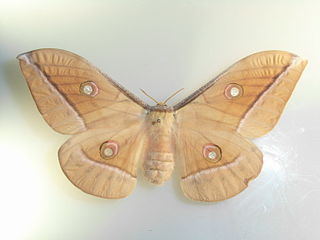
Antheraea is a moth genus belonging to the family Saturniidae. The genus was erected by Jacob Hübner in 1819. Several species of this genus have caterpillars which produce wild silk of commercial importance. Commonly called "tussar silk", the moths are named tussar moths after the fabric.
Cneoglossidae is a family of beetles, in the large suborder Polyphaga.
Deroplatyini is a tribe of the subfamily Deroplatyinae of the family Mantidae of Mantodea.
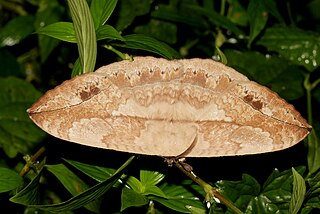
Eupterote is a genus of moths in the family Eupterotidae. It was first described by Jacob Hübner in 1820.
Contacyphon is a genus of marsh beetles in the family Scirtidae. There are about 17 described species in Contacyphon.
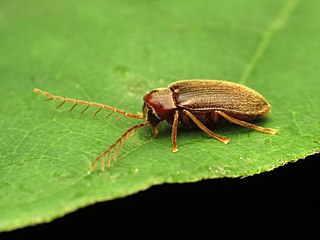
Ptilodactylidae is a family of toe winged beetles in the order Coleoptera. There are about 6 genera and 15 described species of North American Ptilodactylidae.

Pyrgomorpha is the type genus of grasshoppers in the family Pyrgomorphidae and the tribe Pyrgomorphini. Species are found in Southern Europe, Africa and the middle East, through to India and Mongolia.

Sacodes is a genus of marsh beetles in the family Scirtidae. There are about seven described species in Sacodes.

Elodes is a genus of marsh beetles in the family Scirtidae. There are more than 60 described species in Elodes.
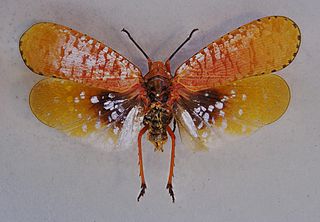
Aphaena is a genus of planthoppers in the sub-family Aphaeninae and the tribe Aphaenini Blanchard, 1847. Species are distributed from eastern India, Indo-China, China and Malesia.

Polydictya is a genus of planthoppers in the sub-family Poiocerinae Haupt, 1929. Species are distributed from India, through Indo-China, to Malesia.
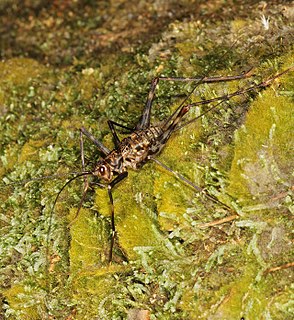
The Phalangopsidae are a recently reconstituted family of crickets, based on the type genus PhalangopsisServille, 1831 from South America. Priority for family-group names based on this genus dates from Blanchard's "Phalangopsites".

Eurybrachys is a genus of bugs in the family Eurybrachidae. First formally named in 1834 by French entomologist Félix Édouard Guérin-Méneville, Eurybrachys is the type genus of the family Eurybrachidae. The spelling Eurybrachis, by the author, is considered an unaccepted orthographic variant. Species in this genus occur in Asia.

















